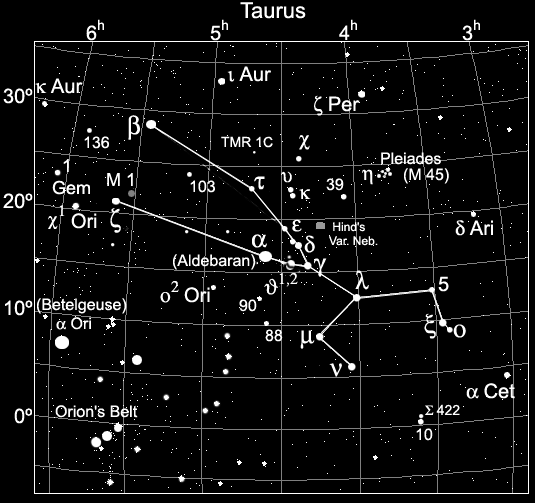
Taurus' appearance in the eastern skies announces the imminent arrival of winter, with Orion following behind. A number of notable objects suitable for binoculars are found in Taurus, none more notable than the Pleiades, although the star cluster around Aldebaran known as The Hyades is also quite magnificent. On the other hand, the Crab Nebula, also found in Taurus, will only appear as a dim fuzzy patch of grey; a large telescope is needed for this famous remnant of a supernova.

Alpha Tauri, "Aldebaran" (The Follower or The Bright One of the Follower), since apparently it trails the Pleiades. Aldebaran is the Eye of the Bull, as it stares defiantly at Orion. Aldebaran is in the same field as the Hyades star cluster, but isn't a part of this cluster as it is much closer at 65 light years. From Orion's Belt (notice the slight curve upwards!) draw an imaginary line toward the northwest. Aldebaran is the first bright star you'll come across. Placing Aldebaran on the left edge of the FOV the stars form a pleasant group in the centre of the Hyades. Gamma is at the right edge and epsilon at the upper edge. In the middle are the two theta stars, a wide double of subtle colour difference, yellow and white. Now the two horns. These aren't terribly apparent, as the only indication of their existence is the tip of each horn. The upper horn is the brighter star, beta Tauri.
Beta Tauri, "El Nath" (The Butting One), represents the tip of the Bull's upper (northern) horn. Beta Tauri is fairly bright at a visual magnitude of 1.65 (a bit brighter than its companion tip, zeta). It's easily found by starting at Betelgeuse and drawing an imaginary line to Capella, that very bright star far to the north. Half way along that line will be found El Nath, beta Tauri, in a rather lonely neighbourhood. This star, beta Tauri, is also the door to entering Auriga for the same star is shared with Auriga and is sometimes known as gamma Aurigae. The other horn tip is to the south-southeast. With the naked eye, from El Nath move directly towards Betelgeuse; you'll encounter zeta Tauri before you get half the distance. In zeta's vicinity is the famous Crab Nebula.
Lambda Tauri is an interesting variable which can be studied over the course of several nights. The star is an eclipsing binary in which the companion partially eclipses the primary every four days. This means that once you establish the maximum, it will last another two nights before it begins to dim. Then it remains at the minimum very briefly, just one evening, before beginning to brighten again. The maximum is about 3.4 while the minimum is 4.2. To find lambda start at Aldebaran. Move thirty-five arc-minutes to the west and four degrees south. To gauge the visual magnitude of lambda, compare with nearby gamma (3.65) to the northeast about half way to Aldebaran, and xi (3.73) to the southwest the same apparent distance as Aldebaran.
Although Zeta Tauri represents the southern tip of the Horns of Taurus, it doesn't seem to have been given a specific name in antiquity. Zeta Tauri is a shell star, which means material is being ejected from its surface. This activity seems to be quite violent at times. Like many shell stars zeta Tauri is classified as variable, but one which doesn't change its visual magnitude (2.97) substantially. To the northwest just over one degree is found the Crab Nebula, In 7x35s the nebula looks like a faint star. In fact you may not be able to locate it among the real stars here. In 10x50s the spot is a bit larger and brighter and has taken on a fuzzy elliptical aspect. At least you can now mentally mark the spot for future study. You probably considered Orion as being far to the south. Yet here, just to the east, is the club held high by Orion as he threatens the bull. Putting zeta Tauri just outside the northwest edge of your field of vision, you'll find the stars which constitute the tip of Orion's club.
